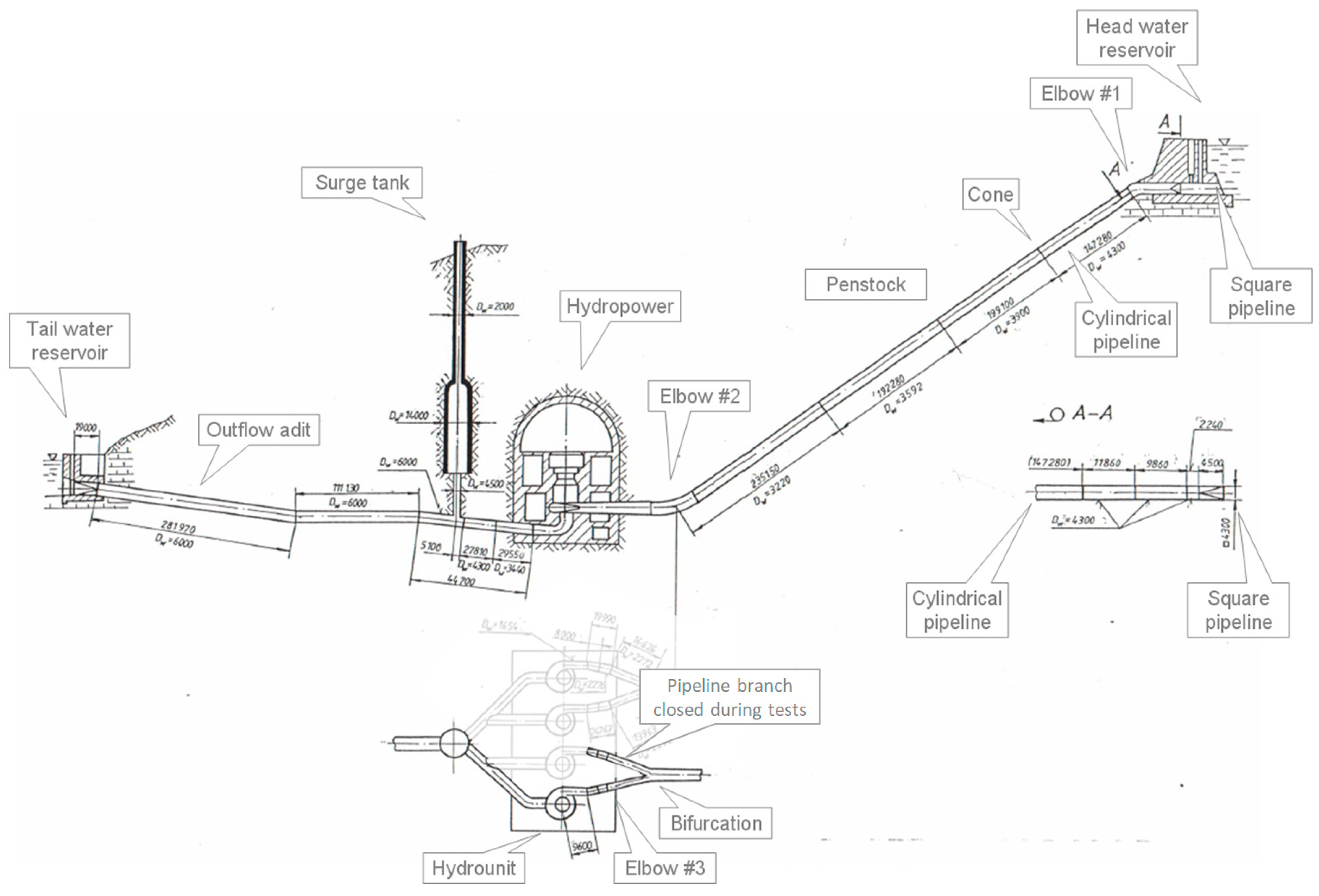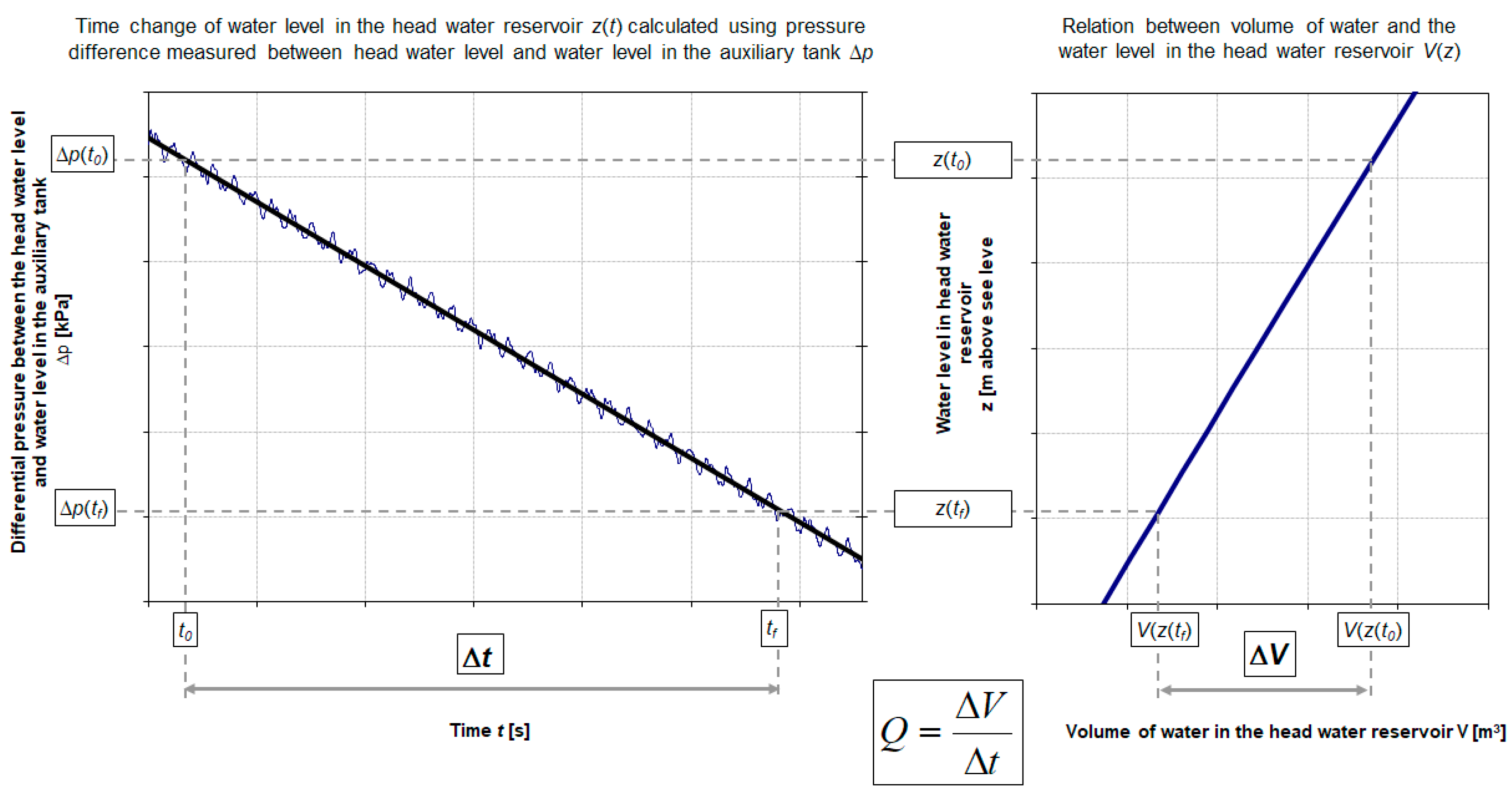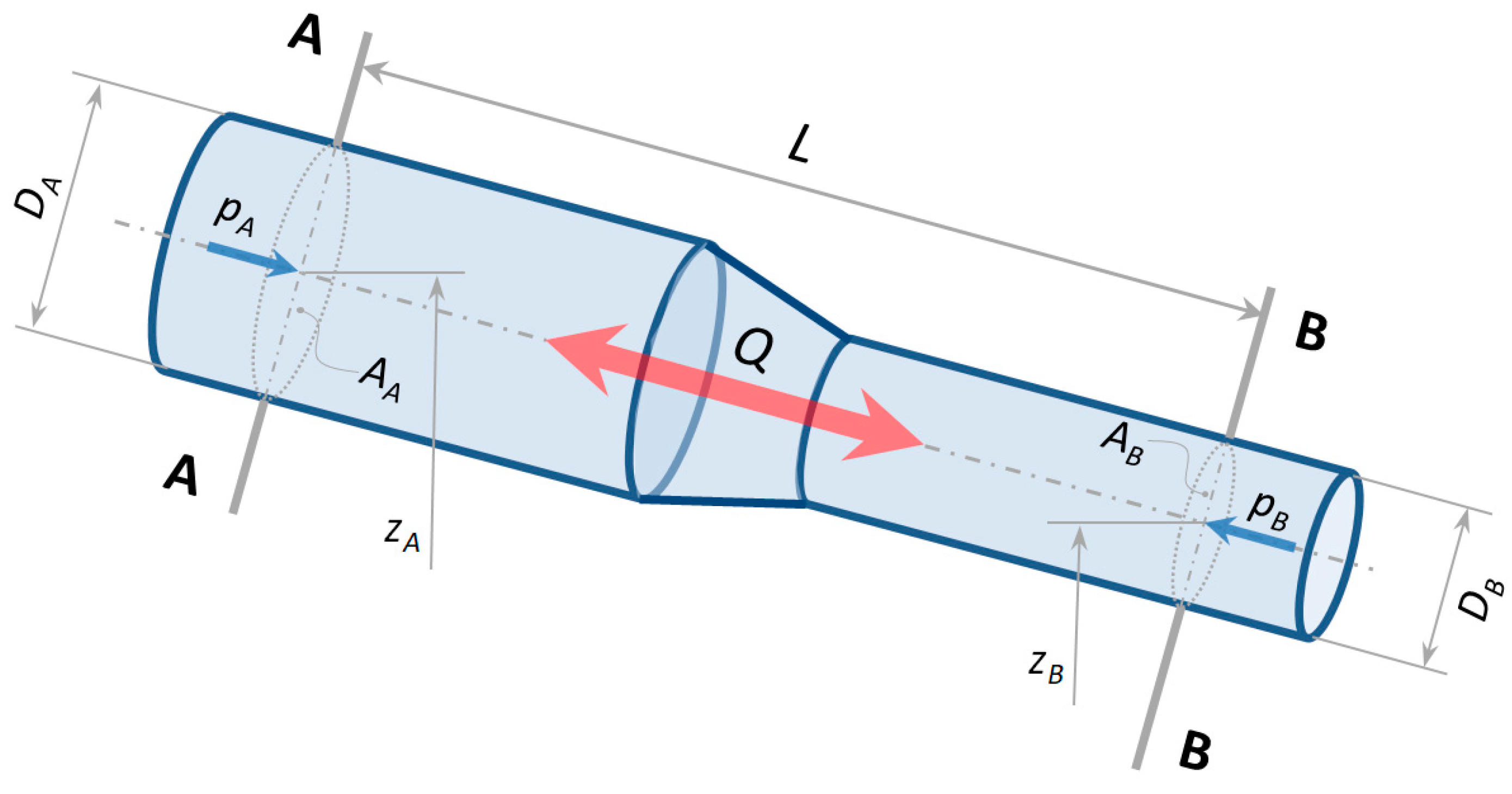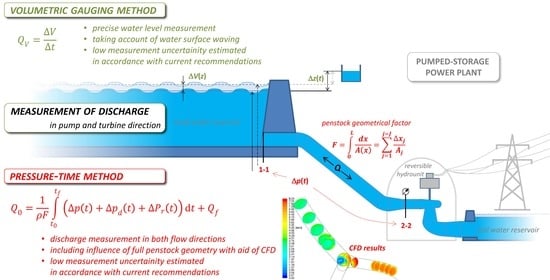Measurements of Discharge through a Pump-Turbine in Both Flow Directions Using Volumetric Gauging and Pressure-Time Methods
Abstract
:1. Introduction
- The velocity-area method—utilizing the distribution of local liquid velocities, measured using propeller current meters (especially in cases of large conduit diameters) or Pitot tubes (for smaller diameters and flow of liquids free of sediments). The volumetric flow rate is determined by integrating the velocity distribution over the entire area of the measuring cross-section.
- The pressure-time method (often called the Gibson method [7,8])—consisting of measuring the time course of changes in the pressure difference between two cross-sections of a closed conduit while stopping the liquid stream by means of a shut-off device. The volumetric flow rate of the liquid at the initial conditions, prior to the stoppage of the flow, is determined by appropriate integration of the change in pressure difference measured during the stoppage of the flow.
- The tracer method—consisting of measurements of the passing time, or concentration, of the radioactive or non-radioactive marker (e.g., salt) between two cross-sections of a conduit. The method requires long conduits and suitable conditions for good mixing of the marker.
- The volumetric gauging method—consisting of determining the variation of the water volume stored in the headwater or tailwater reservoir on the basis of the variation of the water level in this reservoir over time.
- The acoustic method—based on vector summation of the sound wave propagation speed and the average liquid flow velocity—it uses a difference in frequencies or passing times of the emitted and received acoustic signal.
- Applying a special procedure for measuring of water level changes in the upper reservoir using the volumetric method.
- Taking into account the complex geometry of measuring section of the pipeline and its impact on flow phenomena using techniques based on computational fluid dynamics (CFD) and applying these results in the pressure-time method.
2. Materials and Methods
2.1. The Research Object
2.2. The Volumetric Gauging Method
2.3. The Pressure-Time Method
2.3.1. Basic Information
2.3.2. CFD Based Correction of Penstock Geometrical Factor
- The water velocity distributions inside the area of the penstock inflow/outflow (in the cross-sections near the head water reservoir) are different for the turbine and pump operation modes.
- The largest irregular flow occurs in the penstock branch and despite the fact that it only affects the velocity distribution locally, the propagation of these irregularities in the direction of the water flow is clearly more visible than in the opposite direction. The intensity of the flow disturbance decreases rapidly with distance. On the other hand, the smallest flow irregularities in the penstock are induced by the existing short tapered pipe sections.
- The velocity distributions in the elbows also differ depending on the direction of flow, which is quite obvious—the elbows induce disturbances in the flow pattern, which propagate to the next penstock components with decreasing intensity. For example, for the turbine operation mode the flow achieving the elbow #2 is almost uniform because of the long straight section of pipe before this elbow (looking in turbine flow direction), while in pump operation mode, a similar effect takes place in elbow #1.
2.3.3. Flow Rate Measurement, Uncertainty
3. Results and Discussion
- Volumetric gauging method: standard and extended uncertainties were not greater than +/−0.38% and +/−0.76%, respectively, for all measured flow rates—Appendix B;
- Pressure-time method: standard and extended uncertainties were not greater than +/−1.0% and +/−1.1%, respectively, for all measured flow rates—Appendix C.
3.1. Turbine Operation Mode
3.2. Pumping Operation Mode
- Shutoff during pumping is characterized by much more irregular pressure changes than when cutting off flow during turbine mode of operation. This is related to the fact that during turbine operation, the flow was cut off while maintaining the generator connected to the network, while in pump operation, complete flow cut-off with the motor connected to the network was unacceptable.
- At the final stage of closing the machine’s wicket gates, during pump operation, there is a short change in the direction of fluid flow—from the pump to the turbine direction;
- Due to the direction of flow, it should be noted that the pump operation mode, in contrast to the turbine operation mode, induces pressure pulsations with a much higher level, which propagate along the pipeline and have a direct impact on the measured pressure difference.
- The flow in the pump direction takes place along the expanding flow elements of the pipeline (diffusers), which is the reason for greater hydraulic losses (pressure losses occur due to local losses caused by greater turbulence in the boundary layers) and as a result requires greater correction of the F geometrical factor compared to turbine flow (and flow through the confusors).
4. Conclusions
Author Contributions
Funding
Conflicts of Interest
Nomenclature
| A | area; [m2], |
| D | internal diameter of a pipeline; [m], |
| ek | kinetic energy per unit of mass (specific kinetic energy); [J/kg], |
| F | geometrical factor of a pipeline; [m−1], |
| L, l | pipeline length; [m], |
| mass flow rate; [kg/s], | |
| p | pressure; [Pa], |
| Q | volumetric flow rate; [m3/s], |
| t | time; [s], |
| u | absolute standard uncertainty, |
| V | water volume [m3] or water flow velocity; [m/s], |
| x | distance along pipeline axis; [m], |
| x, y, z | coordinates; [m], |
| Y | turbine guide vane opening; [%], |
| Δf | relative deviation factor of F factor; [%], |
| ρ | liquid density; [kg/m3], |
| δ | relative standard uncertainty [%]. |
| Indexes | |
| d | dynamic pressure value, |
| e | equivalent value, |
| f | final value |
| I | total number of numerical cross-sections in a considered pipeline; [-], |
| J | total number of sub-segments with different dimensions (geometry) in a considered pipeline; [-], |
| m | average (mean) value, |
| r | hydraulic resistance |
| 0 | initial value. |
Appendix A. Procedure for Calculating Equivalent Geometrical F Factor in The Pressure-Time Method for Pipelines with Irregular Shape Sections of the on the Basis of CFD Analysis
- Step 1:
- Determination of the geometry of the considered pipeline flow system, discharge Qj, etc., and the computational control flow space—Figure A1.
- Step 2:
- Step 3:
- Simulation of velocity field V(x,y,z) in the flow elements of the considered pipeline within the frame of the computational control space using CFD computer software.
- Step 4:
- Computation of mean flow velocity, Vai, for each i-th numerical cross-section from the previously derived CFD results (step 3), and assumption of equal kinetic energy resulting from the simulated and the uniform flow velocity distributions:where Vi is the flow velocity axial component—the component perpendicular to the i-th numerical cross-section.
- Step 5:
- Computation of the equivalent cross-sectional area, Aei, for each numerical cross-section (i = 1, 2, ..., I) using the continuity equation Qj = Vai Aei = const:
- Step 6
- Computation of coordinates of flow velocity centers in each i-th numerical cross-section, i = 1, 2, ..., I:
- Step 7:
- For the considered flow rate Qj through the analyzed pipe element, computing the equivalent factor FeQj from the formula:where li→i+1 denotes the distance between the resultant velocity centers for computational sections i and i + 1, Aei and Ae i+1—equivalent areas of computational cross-sections i and I + 1, respectively.
Appendix B. Analysis of the Uncertainty of Measuring the Flow Rate by the Volumetric Gauging Method
- Accuracy of geodetic measurements of the geometry of the head water reservoir of the power plant in order to determine the volume of water contained in it as a function of the water level
- Accuracy class of the differential transducer used
- The accuracy of the measurement data acquisition system used
- Sampling frequencies of the differential transducer and accuracy of measuring the time interval in which the measurement took place
- Selection of the time interval from t0 to tf, used to calculate the change in the volume of water in the reservoir taking into account waves on water surface
| Name | Designation | Value | Unit |
|---|---|---|---|
| relative uncertainty in determining the reservoir volume | δ (ΔV) | 0.4000 | % |
| relative standard uncertainty in determining the reservoir volume | δB(ΔV) | 0.2309 | % |
| standard uncertainty of water level measurement | uB(Δz) | 0.0022 | m |
| relative standard uncertainty of measurement of water level related to a change in level of 1 m | δB(Δz) | 0.2165 | % |
| standard uncertainty of water level measurement resulting from the measurement card used | uB(ΔzDAQ) | 0.0005 | m |
| relative standard uncertainty of water level measurement resulting from the measurement card used | δB(ΔzDAQ) | 0.0454 | % |
| standard uncertainty of time interval measurement | uB(Δt) | 0.1000 | s |
| relative standard uncertainty of a time interval measurement | δB(Δt) | 0.0028 | % |
| relative standard uncertainty due to the nature of the changes in the measured change in water level | δA(Qv) | 0.2000 | % |
| total standard uncertainty of flow rate measurement | δc(Qv) | 0.3772 | % |
| expanded uncertainty of flow rate measurement (k = 2) | δ (Qv)k=2 | 0.7544 | % |
Appendix C. Uncertainty Analysis of Flow Rate Measurements by Means of the Pressure-Time Method
- δ(Qf) = ~0.07% for turbine mode of operation,
- δ(Qf) = ~0.065% for pump mode of operation.
| Name | Symbol | Value | Unit | |
|---|---|---|---|---|
| Turbine | Pump | |||
| standard uncertainty of pressure measurement resulting from the applied differential pressure transducer | ukB(Δpm) | 0.4330 | kPa | |
| standard uncertainty of pressure measurement resulting from the measurement card used | urB(Δpm) | 0.0907 | kPa | |
| total standard uncertainty of pressure measurement | u(Δpm) | 0.4424 | kPa | |
| relative standard uncertainty of pressure measurement related to the average differential pressure increase | δ(Δpm) | 0.3600 | 0.4300 | % |
| standard uncertainty of calculating friction losses | uB(Prm) | 0.0555 | 0.1458 | kPa |
| relative standard uncertainty of calculating friction losses | δB(Prm) | 0.0584 | 0.1487 | % |
| standard uncertainty of calculating the dynamic pressure difference | uB(Δpdm) | 0.2100 | 0.1600 | kPa |
| relative standard uncertainty of calculating the dynamic pressure difference | δ(Δpdm) | 0.2211 | 0.1633 | % |
| standard uncertainty of time interval measurement | uB(Δt) | 0.0007 | 0.0005 | s |
| relative standard uncertainty of time measurement | δB(Δt) | 0.0029 | 0.0029 | % |
| standard uncertainty resulting from setting the upper limit of integration | utfA(Q0) | 0.0270 | 0.0280 | m3/s |
| relative uncertainty resulting from setting the upper limit of integration | δtfA(Q0) | 0.0800 | 0.1000 | % |
| standard uncertainty of determining the geometrical factor | δ(Fgeom) | 0.1500 | % | |
| standard uncertainty of CFD calculations | δ(FCFD) | 0.1500 | % | |
| total standard uncertainty of determining the geometric factor | δ (F) | 0.2100 | % | |
| uncertainty of determining the flow rate at final conditions | δ(Qf) | 0.0700 | 0.0650 | % |
| uncertainty resulting from iterative calculation of the flow rate | δ(Qiter) | 0.1000 | % | |
| relative total standard uncertainty | δc(Q0) | 0.4973 | 0.5496 | % |
| relative expanded uncertainty (k = 2) | δ(Q0)k=2 | 0.9946 | 1.0991 | % |
References
- Merzkirch, W. Fluid Mechanics of Flow Metering; Merzkirch, W., Ed.; Springer: Berlin/Heidelberg, Germany; New York, NY, USA, 2005; ISBN 3-540-22242-1. [Google Scholar]
- Miller, R.W. Flow Measurement Engineering Handbook, 3rd ed.; McGraw-Hill Book Company: New York, NY, USA, 1996. [Google Scholar]
- Urquiza, G.; Basurto, M.A.; Castro, L.; Adamkowski, A.; Janicki, W. Flow measurement methods applied to hydro power plants, Chapter 7. In Flow Measurement; Urquiza, G., Castro, L., Eds.; INTECH Open Access Publisher: Rijeka, Croatia, 2012; pp. 151–168. [Google Scholar]
- Field Acceptance Tests to Determine the Hydraulic Performance of Hydraulic Turbines, Storage Pumps and Pump-Turbines; IEC 41:1991; European Equivalent: EN 60041:1999; International Electrotechnical Commision: Geneva, Switzerland, 1991.
- Hydraulic Machines—Acceptance Tests of Small Hydroelectric Installations; IEC 62006:2010; European Equivalent: EN 62006:2011; International Electrotechnical Commision: Geneva, Switzerland, 2010.
- Hydraulic Turbines and Pump-Turbines. Performance Test Codes; ASME PTC 18 Standard; The American Society of Mechanical Engineers: New York, NY, USA, 2011.
- Gibson, N.R. The Gibson method and apparatus for measuring the flow of water in closed conduits. ASME Power Div. 1923, 45, 343–392. [Google Scholar]
- Gibson, N.R. Experience in the use of the Gibson method of water measurement for efficiency tests of hydraulic turbines. ASME J. Basic Eng. 1959, 81, 455–487. [Google Scholar] [CrossRef]
- Voser, A.; Bruttin, C.; Prénat, J.-E.; Staubli, T. Improving acoustic flow measurement. Water Power Dam Constr. 1996, 48, 30–34. [Google Scholar]
- Lüscher, B.; Staubli, T.; Tresch, T.; Gruber, P. Accuracy analysis of the acoustic discharge measurement using analytical, spatial velocity profiles. In Proceedings of the Hydro 2007, Granada, Spain, 15–17 October 2007. Paper 17.05. [Google Scholar]
- Adamkowski, A. Discharge measurement techniques in hydropower systems with emphasis on the pressure-time method. Chapter 5. In Hydropower–Practice and Application; Hossein, S.-B., Ed.; INTECH Open Access Publisher: London, UK, 2012; pp. 83–114. [Google Scholar]
- Doering, J.C.; Hans, P.D. Turbine discharge measurement by the velocity-area method. J. Hydraul. Eng. 2001, 127, 747–752. [Google Scholar] [CrossRef]
- Gandhi, B.K.; Verma, H.K. Simultaneous multi-point velocity measurement using propeller current meters for discharge evaluation in small hydropower stations. In Proceedings of the International Conference on Small Hydropower Hydro Sri Lanka, Kandy, Sri Lanka, 22–24 October 2007. [Google Scholar]
- Proulx, G.; Cloutier, E.; Bouhadji, L.; Lemon, D. Comparison of discharge measurement by current meter and acoustic scintillation methods at La Grande-1. In Proceedings of the IGHEM, Luzern, Swiss, 14–16 July 2004. [Google Scholar]
- Llobet, J.V.; Lemon, D.D.; Buermans, J.; Billenness, D. Union Fenosa Generación’s field experience with Acoustic Scintillation Flow Measurement. In Proceedings of the IGHEM, Milan, Italy, 3–6 September 2008. [Google Scholar]
- Adamkowski, A.; Janicki, W.; Krzemianowski, Z.; Lewandowski, M. Volumetric gauging method vs Gibson method—Comparative analysis of the measurement results of discharge through pomp-turbine in both operation modes. In Proceedings of the IGHEM 2016, Linz, Austria, 24–26 August 2016; p. 567. [Google Scholar]
- Adamkowski, A.; Lewandowski, M. Some experiences with flow measurement in bulb turbines using the differential pressure method. IOP Conf. Ser. Earth Environ. Sci. 2012, 15, 062045. [Google Scholar] [CrossRef]
- Adamkowski, A.; Lewandowski, M.; Lewandowski, S.; Cicholski, W. Calculation of the cycle efficiency coefficient of pumped-storage power plant units basing on measurements of water level in the head (tail) water reservoir. In Proceedings of the 13th International Seminar on Hydropower Plants, Vienna, Austria, 24–26 November 2004. [Google Scholar]
- Uncertainty of Measurement—Part 3: Guide to the Expression of Uncertainty in Measurement; (GUM: 1995), ISO/IEC GUIDE 98-3:2008; International Organization for Standarization: Geneva, Switzerland, 2008.
- Çengel, Y.A.; Cimbala, J.M. Fluid Mechanics. Fundamentals and Applications; McGraw-Hill Book Company: New York, NY, USA, 2006. [Google Scholar]
- White, F.M. Fluid Mechanics; WCB/McGraw-Hill: Boston, MA, USA, 1999. [Google Scholar]
- Adamkowski, A.; Janicki, W. Elastic water-hammer theory–based approach to discharge calculation in the pressure-time Method. J. Hydraul. Eng. 2017, 143, 06017002. [Google Scholar] [CrossRef]
- Adamkowski, A.; Janicki, W.; Krzemianowski, Z.; Lewandowski, M. Flow rate measurements in hydropower plants using the pressure-time method—Experiences and improvements. Flow Meas. Instrum. 2019, 68, 101584. [Google Scholar] [CrossRef]
- Adamkowski, A.; Krzemianowski, Z.; Janicki, W. Improved Discharge Measurement Using the Pressure-Time Method in a Hydropower Plant Curved Penstock. ASME J. Eng. Gas Turbines Power 2009, 131, 053003. [Google Scholar] [CrossRef]
- Adamkowski, A.; Janicki, W. Selected problems in calculation procedures for the Gibson discharge measurement method. In Proceedings of the IGHEM, Roorkee, India, 21–23 October 2010; pp. 73–80. [Google Scholar]
- Bortoni, E.C. New developments in Gibson’s method for flow measurement in hydro power plants. Flow Meas. Instrum. 2008, 19, 385–390. [Google Scholar] [CrossRef]
- Jonsson, P.P.; Ramdal, J.; Cervantes, M.J. Development of the Gibson method—Unsteady friction. Flow Meas. Instrum. 2012, 23, 19–25. [Google Scholar] [CrossRef]
- Dunca, G.; Iovănel, R.G.; Bucur, D.M.; Cervantes, M.J. On the Use of the Water Hammer Equations with Time Dependent Friction during a Valve Closure, for Discharge Estimation. J. Appl. Fluid Mech. 2016, 9, 2427–2434. [Google Scholar] [CrossRef]
- Sundstrom, L.R.J.; Saemi, S.; Raisee, M.; Cervantes, M.J. Improved frictional modeling for the pressure-time method. Flow Meas. Instrum. 2019, 69, 101604. [Google Scholar] [CrossRef]
- Adamkowski, A.; Lewandowski, M. Experimental Examination of Unsteady Friction Models for Transient Pipe Flow Simulation. ASME J. Fluids Eng. 2006, 128, 1351–1363. [Google Scholar] [CrossRef]
- NUMECA International—Computational Fluid Dynamics Software and Consulting Service. Available online: https://www.numeca.com (accessed on 15 August 2020).
- ANSYS Inc. ANSYS Fluent User’s Guide 18; Release 18; ANSYS Inc.: Canonsburg, PA, USA, 2017. [Google Scholar]
- Menter, F.R. Two-equation eddy-viscosity turbulence models for engineering applications. AIAA J. 1994, 32, 269–289. [Google Scholar] [CrossRef] [Green Version]
- Wilcox, D.C. Turbulence Modeling for CFD; DCW Industries, Inc.: La Canada, CA, USA, 1993. [Google Scholar]
- Hellsten, A.; Laine, S. Extension of the k-ω-SST Turbulence Models for Flows over Rough Surfaces; AIAA Paper; AIAA-97-3577; AIAA: Reston, VA, USA, 1997. [Google Scholar] [CrossRef]
- Ramdal, J.; Jonsson, P.P.; Dahlhaug, O.G.; Nielsen, T.K.; Cervantes, M. Uncertainties for pressure-time efficiency measurements. In Proceedings of the IGHEM 2010, Roorkee, India, 21–23 October 2010; pp. 64–72. [Google Scholar]
- Hulås, H.; Dahlhaug, O.G. Uncertainty analysis of Pressure-Time measurements. In Proceedings of the IGHEM 2006, Portland, OR, USA, 30 July–1 August 2006; pp. 1–13. [Google Scholar]
- Brunone, B.; Golia, U.M.; Greco, M. Some Remarks on the Momentum Equations for Fast Transients. In Proceedings of the 9th Round Table, IAHR, International Meeting on Hydraulic Transients with Column Separation, Valencia, Spain, 4–6 September 1991; pp. 201–209. [Google Scholar]
- Bughazem, M.B.; Anderson, A. Problems with Simple Models for Damping in Unsteady Flow. In Proceedings of the International Conference on Pressure Surges and Fluid Transients, BHR Group, Harrogate, UK, 16–18 April 1994; pp. 537–548. [Google Scholar]
- Vitkovsky, J.P.; Lambert, M.F.; Simpson, A.R.; Bergant, A. Advances in Unsteady Friction Modeling in Transient Pipe Flow. In Proceedings of the 8th International Conference on Pressure Surges, The Hague, The Netherlands, 12–14 April 2000; pp. 471–482. [Google Scholar]











| Machine Operation Mode | Discharge, Q0 | Relative Difference of F-Factor, Δf |
|---|---|---|
| - | m3/s | % |
| Turbine operation mode | 20 | 0.15 |
| 25 | 0.14 | |
| 30 | 0.13 | |
| 35 | 0.11 | |
| Pump operation mode | 26 | 0.77 |
| 28 | 0.77 |
© 2020 by the authors. Licensee MDPI, Basel, Switzerland. This article is an open access article distributed under the terms and conditions of the Creative Commons Attribution (CC BY) license (http://creativecommons.org/licenses/by/4.0/).
Share and Cite
Adamkowski, A.; Janicki, W.; Lewandowski, M. Measurements of Discharge through a Pump-Turbine in Both Flow Directions Using Volumetric Gauging and Pressure-Time Methods. Energies 2020, 13, 4706. https://doi.org/10.3390/en13184706
Adamkowski A, Janicki W, Lewandowski M. Measurements of Discharge through a Pump-Turbine in Both Flow Directions Using Volumetric Gauging and Pressure-Time Methods. Energies. 2020; 13(18):4706. https://doi.org/10.3390/en13184706
Chicago/Turabian StyleAdamkowski, Adam, Waldemar Janicki, and Mariusz Lewandowski. 2020. "Measurements of Discharge through a Pump-Turbine in Both Flow Directions Using Volumetric Gauging and Pressure-Time Methods" Energies 13, no. 18: 4706. https://doi.org/10.3390/en13184706







